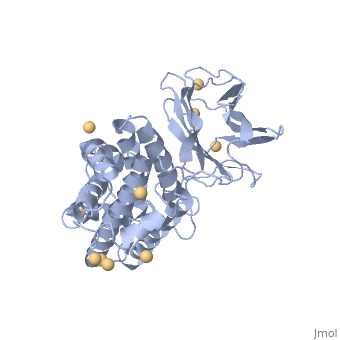1ca1
From Proteopedia
ALPHA-TOXIN FROM CLOSTRIDIUM PERFRINGENS
Structural highlights
Function[PHLC1_CLOPE] Bacterial hemolysins are exotoxins that attack blood cell membranes and cause cell rupture. Constitutes an essential virulence factor in gas gangrene. Binds to eukaryotic membranes where it hydrolyzes both phosphatidylcholine and sphingomyelin. The diacylglycerol produced can activate both the arachidonic acid pathway, leading to modulation of the inflammatory response cascade and thrombosis, and protein kinase C, leading to activation of eukaryotic phospholipases and further membrane damage. Acts on human and mouse erythrocytes, but not on rabbit or horse erythrocytes. Evolutionary ConservationCheck, as determined by ConSurfDB. You may read the explanation of the method and the full data available from ConSurf. Publication Abstract from PubMedClostridium perfringens alpha-toxin is the key virulence determinant in gas gangrene and has also been implicated in the pathogenesis of sudden death syndrome in young animals. The toxin is a 370-residue, zinc metalloenzyme that has phospholipase C activity, and can bind to membranes in the presence of calcium. The crystal structure of the enzyme reveals a two-domain protein. The N-terminal domain shows an anticipated structural similarity to Bacillus cereus phosphatidylcholine-specific phospholipase C (PC-PLC). The C-terminal domain shows a strong structural analogy to eukaryotic calcium-binding C2 domains. We believe this is the first example of such a domain in prokaryotes. This type of domain has been found to act as a phospholipid and/or calcium-binding domain in intracellular second messenger proteins and, interestingly, these pathways are perturbed in cells treated with alpha-toxin. Finally, a possible mechanism for alpha-toxin attack on membrane-packed phospholipid is described, which rationalizes its toxicity when compared to other, non-haemolytic, but homologous phospholipases C. Structure of the key toxin in gas gangrene.,Naylor CE, Eaton JT, Howells A, Justin N, Moss DS, Titball RW, Basak AK Nat Struct Biol. 1998 Aug;5(8):738-46. PMID:9699639[1] From MEDLINE®/PubMed®, a database of the U.S. National Library of Medicine. See AlsoReferences
| ||||||||||||||||||||


